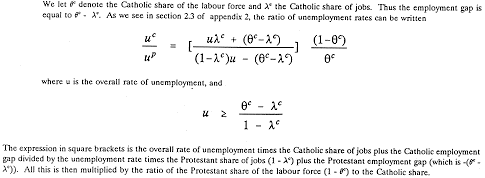OF UNEMPLOYMEENT RATES AS AN INDICATOR OF FAIR EMPLOYMENT
Northern Ireland Economic Research Centre and Professor Richard Breen Centre for Social Research The Queen's University of Belfast
(1996)
The working of the model is shown through a series of simulations.
These start with actual conditions as they were in 1971 and calculate
annual changes over a 20 year period under a series of realistic
assumptions. Initially, we allow one factor at a time to vary
in order to assess the individual impact of each factor. Then
the individual influences are added cumulatively to show how they
jointly contribute to produce the observed unemployment ratio
on 2.2 in 1991. Table 4 reports the results of five simulations using the model and these are shown graphically in Figure 4. In each of these simulations we allow at most one parameter to differ as between Catholics and Protestants. This is done for four individual factors. No results are shown for differences in changes in participation rates as these are so slight as to make little difference to the results. 1 No Differences
Simulation 1 sets both Protestants and Catholics to have the same
rate of growth in the working-age population, the same
rates of migration, the same quit rates, the same
rates of labour force participation and no Catholic
disadvantage in the sharing of available jobs. With these
parameters we see that the ratio of unemployment rates moves quite
quickly from its 1971 value of 2.6 towards unity (Figure 4). If
we were instead to start the simulation with an unemployment ratio
of unity in the base year, it would not deviate from this value
in subsequent years.
Parameter to Differ Between Catholics and Protestants
Simulation 2 is identical to simulation 1 except that we now allow
the Catholic and Protestant quit rates to take their known
values: 11.4% for Catholics and 9.6% for Protestants. The results
of this simulation show that differential quit rates are insufficient
to maintain the ratios of unemployment rates at their 1971 value.
They tend to fall from the initial value of 2.6. However, differential
rates of labour turnover are sufficient to prevent the ratio reaching
this unity. After 20 years it stands at 1.16 ie Catholic unemployment
remains permanently 16% higher than Protestant unemployment.
3 Catholic Disadvantage
Simulation 3 is once again identical to simulation 1 but this
time we allow there to be Catholic disadvantage (Protestant advantage)
in the sharing of available jobs between the two communities.
We set this parameter so that Catholics acquire 80% of the jobs
they would were there no explicit Catholic/Protestant difference
in the chances of getting a job.[11] Here we see that
the ratio once again falls from its 1971 value and stabilises
around 1.45.
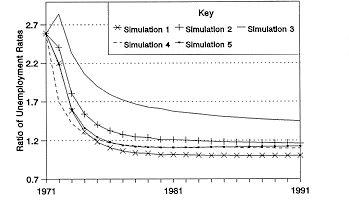 4 Different Growth
Simulation 4 also differs from simulation 1 in only one respect.
We allow the Protestant and Catholic labour forces to grow over
the period at their known rate. Ibis is done by setting rates
of growth in the working-age population for each community at
their known values. As with differences in quit rates, this is
not sufficient to maintain the ratio of unemployment rates at
its 1971 level. After 20 years the ratio has fallen to 1.10, a
level at which it remains stable. 5 Differential Migration
Lastly in Table 4 we report the result of simulation 5 which differs
from simulation 1 in that we allow for differential migration.
The full migration functions are described in appendix 5. The
Catholic migration response to Catholic unemployment is approximately
one-third of the Protestant response to Protestant unemployment.
The result is, once again, that the unemployment rate ratio falls
from its starting value and by the end of the 20 year period it
has stabilised at 1.12.
In practice, of course, several or all of the various factors
will have been simultaneously operative. In this section we examine
the cumulative impact of several factors operating at the same
time. The results for all combinations of factors at year 20 are
set out in Figure 5. As can be seen the unemployment ratio increases
as more factors are included. The important point to note is that
the joint impact of several factors is closer to multiplicative
than additive and in fact is somewhat more than multiplicative.
This is shown in Table 5 which examines how the unemployment ratio
(at year 20) rises as extra influences are successively added.
The unemployment ratio resulting from the impact of single factors,
one at a time, are shown in column 1. These reproduce the values
shown in the third row of Table 4. 'ne second column of Table
5 shows the cumulative impact on the ratio of successively adding
further factors. This can be compared in column 3 with the results
of simply multiplying the ratios calculated from the individual
factors. For instance, multiplying all four of the ratios listed
in column 1 gives a value of 2.07. This is less than the actual
joint impact of 2.20 obtained through a simulation with all four
factors.
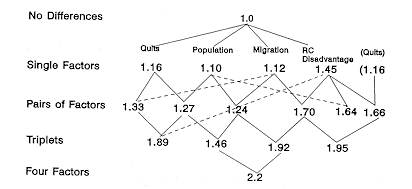
In principle, the four factors could be combined in a large number
of ways. However, it is instructive to consider two cumulative
combinations more carefully. The first is the one illustrated
in Table 5. This is shown in more detail in Figure 6.
Figure 6 starts with no differences between Catholics and Protestants except in rates of population growth and participation. This is the lowest curve in Figure 6 and reproduces simulation 4 in Table 4. The joint impact of higher Catholic population growth and lower Catholic propensity to migrate is shown in the second lowest curve. When differences in quit rates are added, the equilibrium unemployment ratio rises again to around 1.46 as shown in the third curve. Finally, when Catholic disadvantage in hiring at 20% is added the unemployment ratio rises to 2.20 which is close to the observed stable rate in Northern Ireland. This is shown in the top curve in Figure 6.
Figure 6 can be interpreted as saying that without Catholic disadvantage
in hiring the unemployment ratio could be expected to stabilise
at around 1.46. With no Catholic disadvantage and equal quit rates
the long-term equilibrium ratio would be around 1.24. This latter
figure measures the impact of differential population growth combined
with differences in migration propensities. As can be appreciated
these two factors alone do not in themselves raise the ratio by
a very large amount. It is only in combination with differential
quit rates and Catholic disadvantage that they become more important.
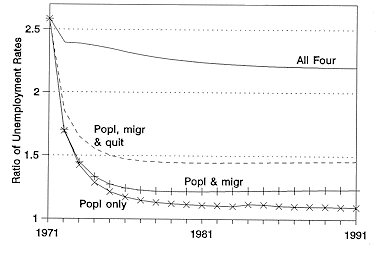 The second cumulative impact begins with the single factor, 'Catholic disadvantage in hiring' of 20%. This is shown as the lowest curve in Figure 7 and reproduces simulation 3 from Table 4. As can be seen, this factor acting alone produces a stable unemployment ratio of close to 1.45. With the addition of differential quit rates the equilibrium ratio rises to 1.66. The higher quit rate for Catholics might reflect Catholic disadvantage, or alternatively could be related to structural factors such as the younger average age of the Catholic workforce. A stable unemployment ratio somewhere between 1.45 and 1.66 might thus represent the impact of Catholic disadvantage and is of considerable interest. A stable unemployment ratio at this level would be close to that predicted from most cross-section studies of 'structural' disadvantage for Catholics, ie around half of the observed unemployment ratio. Since it is most appropriate to view ratios as multiplicative a 50% influence on the unemployment ratio is best measured as the square root of the ratio. In this case the square root of 2.2 is 1.5.
With the addition of differential migration the ratio rises to
1.95, and with the further addition of differential population
growth the stable ratio at 2.20 is close to that actually observed
in Northern Ireland in 1991. The important point to note is that
the addition of differential population growth and migration raises
the stable ratio from 1.66 to 2.20. This is an increase of 33%
despite the fact that the impact of differential migration and
population growth considered in isolation is a ratio of 1.24.
There is a clear, and more than multiplicative interaction between
the various factors which causes the ratio to increase by a relatively
large amount. This fact may help to explain why individually small
influences like population growth and differential migration have
tended to be overlooked in the literature on the unemployment
ratio.
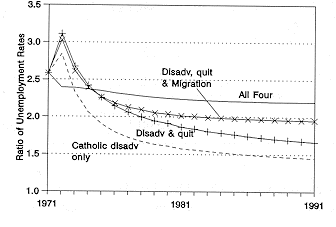
The simulations with all four factors, shown in both Figure 6
and Figure 7 are identical. Both correspond reasonably closely
with the ratio observed in Northern Ireland over the last two
decades. This simulation includes actual differences (as far as
we can determine them) between Catholics and Protestants in population
growth, migration propensities and quit rates. This simulation
also incorporates a level of Catholic disadvantage in hiring which
approximates to the structural disadvantages estimated by several
previous authors. This simulation provides a plausible approximation
to the ratio actually observed in Northern Ireland.
One further property of the simulations is important. This is
that the initial unemployment conditions do not influence the
stable or equilibrium ratio. Moreover, whatever the starting point
the unemployment ratio will very quickly converge to the same
stable level. This is illustrated in Figure 8 which reproduces
the simulation of Figures 6 and 7, including all four factors
simultaneously. This is reproduced as the upper curve in Figure
8. The second curve takes a different starting point. In this
case the unemployment ratio is assumed to be unity in the first
year, ie Catholic and Protestant unemployment rates are assumed
to be the same. As can be seen, whichever ratio of unemployment
rates we start from, the two simulations converge in less than
ten years. This is important because it tells us that the current
observed value of the ratio of rates is not the direct
result of a history of higher Catholic than Protestant unemployment
rates. However, this does not mean that our model is entirely
a-historical. The observed ratio arises because of the values
of the parameters in the model. To the extent that these parameter
values are themselves the product of historical factors, history
influences the level at which the ratio settles. Sensitivity of Unemployment Ratio to Level of Catholic Disadvantage
Table 6 reports a further set of simulations (also shown in Figure
9) that seek to show the sensitivity of the ratio of rates to
the level of Catholic disadvantage. Here we report five simulations
setting the chances of a Catholic job seeker acquiring one of
the vacant jobs at 100%, 90%, 80%, 65% and 50% of the chances
proportionate to the number of job seekers: we report these as
levels of Catholic disadvantage of 0, 10%, 20%, 35% and 50%. Once
again our baseline model is one in which quit rates, participation
rates, rates of natural increase of the working-age population
and of migration all take their observed values, varying between
the two communities. The results show quite clearly how raising
the level of Catholic disadvantage leads to an increase in the
stable ratio of unemployment rates that prevails by year 20. In
the extreme case in which Catholics have half the chance of getting
a job compared with proportionality, the ratio of rates is just
over 4.
FACTORS WITH DIFFERENT INITIAL CONDITIONS
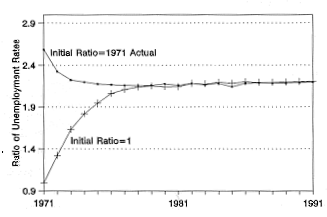
RATES TO CATHOLIC DISADVANTAGE (SEE TABLE 6)
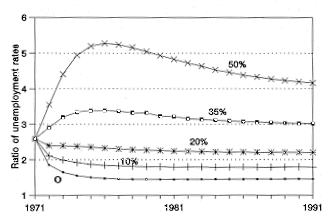
Year 20 to the Level of Catholic Disadvantage
Sensitivity of Unemployment Ratio to Rates of Labour Turnover Table 7 shows how the ratio of rates is sensitive to overall rates of labour turnover or quit rates. Here we allow the two communities to vary in all respects, as before, and set the level of Catholic disadvantage such that they have 80% of the chance which they would have under conditions of strict proportionality. The two communities' quit rates continue to have a slight differential between them. The overall rate of turnover (quits) varies from a little over 2% to 50%. Here we see that the stable ratio of rates that is reached by year 20 is sensitive to quit rates. The ratio is higher at both lower and higher rates of labour turnover. With the lowest rate of turnover of 2.5% the unemployment .ratio rises to 2.7, while at a rate of 50% the ratio rises almost to 3.
Intuitively the reason for this is that the overall quit rate
determines how many jobs are available for redistribution each
year via the sharing mechanism in the model. If the number of
jobs made available in this way is less than the annual growth
in the labour force, the Catholic:Protestant differential in labour
force growth rates will cause the unemployment rate ratio to rise.
On the other hand, high rates of labour turnover (as shown in
the last two simulations in Table 7) will also cause the ratio
to increase, but in this case because the difference between the
two communities in the number of jobs vacated will be large. All
other things equal, a community's rate of unemployment will increase
if it loses more jobs through labour turnover than it gains through
the sharing mechanism. In the case of the high turnover simulations
shown in Table 7 this is what is happening to the Catholic population.
Year 20 to Different Overall Rates of Labour Turnover
The essence of the results reported above is that higher Catholic birth-rates and a lower Catholic propensity to migrate cause Catholic unemployment rates to be higher than that of Protestants. In addition, Catholic unemployment is further boosted by a tendency to leave jobs, for whatever reason, more frequently than Protestants (ie higher quit rates) and by greater difficulty in gaining new jobs (Catholic disadvantage).
None of these factors individually accounts for more than a minority
of the observed differential in unemployment between Catholics
and Protestants. As many have suspected the causes of the unemployment
differential are indeed complex. Tlese four factors interact more
than multiplicatively to result in a high aggregate differential.
The contribution of the factors individually and collectively
to the unemployment differential in year 20 of the simulations
is shown in Figure 5. Only when all four factors are included
does the ratio approach the observed 1991 value of 2.2. Population Growth and Labour Turnover Our interpretation of these results is as follows. A higher Catholic birth-rate leads to a proportionately larger number of job seekers (eg school leavers). Even under conditions of strictly fair employment, this will in itself lead to higher Catholic unemployment, as long as the number of job opportunities is relatively low. Most jobs become available each year through labour turnover rather than via expansion of the economy. Hence, a low rate of labour turnover will restrict job opportunities. The effect can be appreciated most simply by imagining a situation with no job opportunities at all. In this situation all school leavers would become unemployed (assuming no migration). The community with the higher rate of population growth would in this situation experience a greater[12] level of unemployment . Conversely, with labour turnover as high as 100% each year, unemployment rates would quickly equalise between communities. The practical question in the Northern Ireland context is whether the observed 10% rate of labour turnover is in its effect closer to zero than to 100%. The simulations show that a 10% turnover rate is low enough to cause Catholic unemployment to remain permanently above that of Protestants. There are simply not enough available jobs, and the large proportion of Catholic school leavers mean that proportionately more Catholics will be left without work, even assuming proportionality in hiring.
In practice, the impact of higher Catholic population growth is
relatively slight when considered alone. It raises the long-term
unemployment ratio by only around 10%. However, in combination
with other factors its impact is increased. In addition, its impact
would be greater if the rate of labour turnover fell much below
10%. Migration
In addition to the higher Catholic population growth there is
also a. hitherto unmeasured difference in migration between Catholics
and Protestants. The evidence of the 1970s and 1980s is that a
higher proportion of Catholics left Northern Ireland than Protestants
and that the annual migration rate for Catholics was 49% higher
than for Protestants (1.15% pa as compared with 0.77%). However,
the evidence is that a much higher rate of Catholic unemployment
is required to induce a given level of migration for Catholics
than for Protestants. The figures for migration given above are
ex post. What is necessary for understanding the dynamics
of labour market changes are the ex ante migration propensities.
These are included in the model as the parameters c
and p which reflect the sensitivity of Catholic and
Protestant migration, respectively, to the gap in unemployment
rates between each community and the average British level. In
order to reproduce the observed population changes over the 1971-91
period, the model requires a Protestant propensity to migrate
in the face of given unemployment levels which is over three times
higher than for Catholics (p = -0.165, c
= -0.048). As noted above, this conclusion only holds true when
the individual unemployment rates of each of the two communities
is used. If instead the single Northern Ireland unemployment rate
is used then the sensitivity of Catholic migration to unemployment
is 77% higher than for Protestants. This conclusion also depends
on the assumption that rates of automonous migration, unrelated
to unemployment, are equal for Catholics and Protestants. Alternative
assumptions are examined in appendix 5. Balancing Mechanisms As argued above, the striking temporal consistency of the unemployment ratio requires a balancing mechanism, in the economics jargon, an equilibrating or homeostatic mechanism. In fact there are two in the model. One of these is migration. High rates of population growth tend to raise unemployment but migration reduces unemployment. Unemployment continues to rise until the inflows on to the labour market are balanced by migration outflows. At this high level of unemployment both the unemployment rate and the migration outflow stabilise. This is one reason why the changes in unemployment rates in the simulations last for only a few years, after which there is no further change.
The second balancing factor occurs through the job sharing mechanism.
As Catholic unemployment rises the Catholic proportion of total
job seekers increases, and under conditions of proportionate hiring,
Catholic employment rises faster than Protestant employment. This
in turn slows down and eventually halts the increase in the unemployment
ratio. A high level of Catholic unemployment is sufficient to
attract a high enough level of jobs to prevent any further increase
in Catholic unemployment (relative to Protestant unemployment).
The unemployment ratio then stabilises at a high level. Catholic Disadvantage On top of these factors is the additional Catholic disadvantage in hiring which is built into the employment equations in the model. As suggested above it is possible that the higher Catholic quit rate should be considered alongside the more direct disadvantage in hiring for job seekers as part of a wider Catholic disadvantage. Higher Catholic quit rates are most likely to reflect the greater youth of the Catholic labour force (Murphy and Armstrong, 1994). The rate of Catholic disadvantage calculated within the model in 0.8 (ie 80% of the average NI chance of obtaining a job). This equates to 70% of the probability of Protestant job seekers obtaining employment. This level of disadvantage alone generates an unemployment ratio of 1.45 after 20 years. (Over a longer period it continues to fall to 1.30). Higher quit rates together with Catholic disadvantage in hiring lead to an unemployment ratio of 1.66 (Figure 5). This is the result assuming no difference between Catholics and Protestants in either population growth or in migration propensities. When the higher population growth and lower migration propensities of Catholics are added to this the unemployment ratio stabilises at 2.2. This result is important for two reasons. Firstly, the degree of disadvantage assumed (Catholic share of available jobs 20% below their proportionate share) generates an unemployment ratio in line with all previous research on structural disadvantage. By structural disadvantage is meant the higher unemployment which results from factors that in principle affect both communities equally, even though in practice one community may be more vulnerable for understandable reasons. One structural factor is location. Catholics in Northern Ireland live in areas of higher unemployment, chiefly west of the river Bann. Other structural factors are age, occupation or socioeconomic group, family size and family circumstances, and housing tenure. Smith and Chambers, 1991, Murphy and Armstrong, 1994, and Gudgin, 1994a, all agree that such factors account for half of the unemployment ratio in Northern Ireland. These structural disadvantages are summarised by Gudgin, 1994a, as being due to location and occupation in approximately equal measures. Catholics live in high unemployment areas and work in high unemployment locations to a greater extent than do Protestants. These two factors subsume many of the other factors included by Smith and Chambers (1991), and Murphy and Armstrong (1994), in that occupation is for instance correlated with such things as qualification and housing tenure. The only author to disagree significantly with these estimates is Compton, 1991, who ascribes a greater importance to structural factors. Gudgin (1994a), argues that the standardisation procedures used by Compton are biased towards ascribing high values to structural factors. Our interpretation is thus, that the degree of Catholic disadvantage built into the model accounts for the widely observed structural disadvantage of Catholics. This is important because it appears to exclude any wider Catholic difficulty associated with non-structural factors, ie it excludes any substantial level of direct or indirect discrimination or so-called 'chill factors'. This conclusion however contradicts the finding of Murphy and Armstrong (1994) that over half of the disadvantage of Catholic job seekers in obtaining employment is due to non-structural factors. Because of differences in time periods and definitions, the Murphy and Armstrong (1994) result is not directly comparable with the results reported here. In addition, it is possible that part of the Murphy and Armstrong (1994) result may be due to migration differences between Catholics and Protestants. These issues are discussed in appendix 7. We are of course not suggesting that discrimination is absent from Northern Ireland or that chill factors are irrelevant. These things are clearly present in Northern Ireland. Our conclusion is different. It is that it appears perfectly possible to generate a stable unemployment ratio close to that observed in Northern Ireland, assuming only that degree of Catholic disadvantage which is normally described as structural. The second important aspect of the Catholic disadvantage simulations is that the model provides a succinct measure of the impact of structural disadvantage on obtaining and retaining a job. If structural factors account for half of the unemployment ratio, then the model results indicate that this is equivalent to saying that Catholics have a 20% lower chance of gaining new jobs and a slightly higher chance of leaving an existing job. Hence a cross-sectional statement about unemployment has been translated in a statement about the dynamic probability of employment. We should stress that the employment probabilities do not apply to each individual, they are merely simple aggregate descriptions of a complex reality in which employment probabilities vary hugely within the Catholic (or Protestant) community as well as varying (to a lesser degree) between them.
In conclusion to this section our interpretation is that it is
possible to generate a Catholic:Protestant unemployment ratio
of in excess of 2.0 without any assumption about discrimination.
Half of the higher rate of Catholic unemployment can be generate
about migration propensities using known levels of population
growth and assumptions which fit the known facts. The other half
depends on Catholic disadvantage in obtaining and retaining jobs.
The calculated level of Catholic disadvantage appears to equate
t that expected from known structural differences between Catholic
and Protestant labour forces. The ratio of Catholic:Protestant unemployment rates was unknown in Northern Ireland before the 1970s. In recent years it has become the focus of much political and policy attention. Tle ratio of unemployment rates is the most commonly cited measure of the differential labour market position of Catholics and Protestants even though it is by no means the only possible measure and in section 1 of this report we briefly discussed some other measures, their properties and the relationships between them. This section also examined the relationship between the ratio of unemployment rates and the employment gap - the latter being the difference between a community's share of the labour force and its share of total employment. We showed that, when the aggregate rate of unemployment is changing, the ratio of unemployment rates can only be held constant if the employment gap changes approximately in proportion to the Province- wide unemployment rate. In Northern Ireland in the 1971-91 period the ratio of unemployment rates has remained roughly constant around 2.5, while aggregate unemployment has varied between 7% and 21%. In order to maintain such constancy the Catholic employment gap has had to approximately triple as aggregate unemployment has tripled. It is difficult to imagine what economic mechanisms could lead Catholic and Protestant shares of the labour force and employment to respond to changes in unemployment in such a manner as to maintain constancy in the unemployment ratio. It seems probable that one or more equilibrating mechanisms are at work to maintain constancy in the unemployment ratio in a context of large shifts in the aggregate level of unemployment in Northern Ireland. To investigate the nature of such mechanisms a dynamic model of the Northern Ireland labour force was developed. his allowed us to simulate the evolution of the ratio of unemployment rates over the period 1971-91. Here our main conclusions were that the ratio of unemployment rates is susceptible to the influence of several differences between Catholics and Protestants and that these various differences (in rates of labour force participation, population growth, migration, quit rates and disadvantage in hiring) interact in a complex fashion to generate particular values of the ratio of unemployment rates. It was possible to simulate a stable ratio of unemployment rates at around 2.2 (as observed in 1991) with rates of natural increase of the working-age population, labour force participation, labour turnover and migration at their observed average values for the period 1971-91. These factors on their own would however generate only around half of the observed unemployment ratio. It was also necessary to incorporate into the model a degree of Catholic disadvantage in obtaining and retaining employment. The necessary degree of disadvantage corresponded closely with existing and widely accepted measures of structural disadvantage as long as Catholic migration responded to Catholic unemployment and Protestant migration to Protestant unemployment. If however migration in both communities responds instead to the overall Northern Ireland unemployment rate the degree of Catholic disadvantage is greater than can be accounted for by structural factors alone. Our belief is that Catholic migration is at least partly sensitive to Catholic (rather than overall) unemployment. In this case there was little need to assume any degree of Catholic disadvantage which went beyond the accepted confines of structural factors including location, age, and qualifications. In particular, there was little need to invoke more controversial factors, including direct or indirect discrimination or chill factors. Although such factors clearly exist in some individual cases in Northern Ireland, it is quite possible that they are not necessary to generate an unemployment ratio in excess of 2.0. What is also striking is that these factors cause the unemployment ratio to move rapidly towards a stable or equilibrium level. With the observed values for population increase, migration and quit rates, and with disadvantage corresponding to structural factors, the stable level was between 2.0 and 2.5. Moreover, the same stable level was reached irrespective of the labour market conditions at the start of the period. Historical factors are thus entirely captured in its parameter values of its model. These results point to two conclusions. First, the manner in which the set of four factors interact to generate the observed ratio of unemployment rates shows that the ratio of rates cannot be used to infer the presence or absence of fair employment. Likewise - and for the same reason - no change in the degree of Catholic disadvantage could be inferred from changes in the observed value of the ratio. The ratio of unemployment rates is not, then, a valid or reliable indicator of the degree of fair employment in the Northern Ireland labour market. Second, these results suggest that the common practice of deducing from a high unemployment rate ratio that discrimination must be a cause is quite wrong. If it is the case that there is little systematic discrimination in Northern Ireland then any Act aimed at reducing the unemployment ratio by combating systematic discrimination is unlikely to succeed unless it was unintentionally to introduce an element of discrimination against Protestants into the labour market. This is not to say that legislation aimed at combating individual cases of discrimination or sectarian abuse in the workplace would be inappropriate in the circumstances of Northern Ireland.
A more effective means of reducing the unemployment ratio than
legislation is in our view to reduce the numbers unemployed rather
than attempting to switch unemployment from one community to another.
The easiest and most effective way to achieve this within the
policy competencies of government in Northern Ireland would be
to extend the Action for Community Employment Scheme (ACE) to
the extent that all of the long- term unemployed in Northern Ireland
were offered work on a semi-permanent basis. Acting in this way
as, in effect an employer of last resort, government could reduce
the unemployment rate in Northern Ireland by up to half. Since
two-thirds of long-term unemployed males in Northern Ireland are
Catholic, any measure which succeeded in halving unemployment
in this way would reduce the Catholic:Protestant unemployment
ratio to around 1.6. At this level the ratio would be only a little
higher than that between Presbyterians and Church of Ireland members
in Northern Ireland, and would be lower than the Catholic:Protestant
unemployment ratio in the Republic of Ireland.
Compton P A (1991), 'Employment Differentials in Northern Ireland and Job Discrimination: A Critique' in P J Roche and B Barton (eds) The Northern Ireland Question: Myth and Reality, Avebury: Aldershot. Gudgin G and O'Shea G (1993), 'Unemployment Forever: The Northern Ireland Economy in Recession and Beyond', NIERC Research Report No 13. Gudgin G (1994a), 'Catholic and Protestant Unemployment in Ireland.. North and South', NIERC, Mimeo. Gudgin G (1994b), The Distribution of Jobs Between Communities in Northern Ireland Since 1971, Standing Advisory Commission for Human Rights Annual Report 1994. Jackman R and Savouri S (1992), Regional Migration in Britain, An Analysis Using NHS Central Register Data, Economic Journal Vol 102. it Murphy A (1991), Labour Market Analysis in Northern Ireland, NIERC Report for PPRU Department of Finance and Personnel. Murphy A and Armstrong D (1994), 'A Picture of the Catholic and Protestant Male Unemployed', Employment Equality Review, Research Report No 2, Central Community Smith D J and Chambers G (1991), Inequality in Northern Ireland, Oxford: Clarendon U Press. R Standing Advisory Commission on Human Rights (SACHR) (1987), Religious and Political Discrimination and Equality of Opportunity in Northern Ireland: Report of Fair Employment, London, HMSO, cm. 237.
Walsh B (1974), Expectations, Information and Human
Migration: Specifying an Econometric Model of Irish Migration
to Britain, Journal of Regional Science, Vol 14, No 1.
Part 1 Footnotes:
[3] This is also evident if we compare the difference in unemployment rates with their ratio. The ratio can be written as
 And clearly the ratio will be bigger the larger is the difference in unemployment rates (uc - up) as a proportion of the Protestant rate. [4] These figures apply in a context of Catholic share of the economically active at 39%. Although the precise figures vary a little for the different shares of the economically active, the changes are minimal for small variations in the labour force share. [5] Here we give a general description of the model: more details and the full mathematical specification are contained in appendix 3. [6] The allocation of job losses is discussed in more detail in appendix 3. [7] An identity is an equation which holds true by definition. For instance, the definition of labour force as the sum of the employed and unemployed (L= E+ U) is an identity. [8] In reporting these figures we have allocated those respondents to the 1971 census who refused to state their religion to one or the other community grouping using Compton's assumptions about the distribution of the 1971 'Not Stated' respondents. In allocating the 1991 'Not Stated' and 'No Religion' groups we have used estimates based on work carried out at the Northern Ireland Economic Research Centre. [9] These three groups are defined in more detail as follows. Those who have just vacated jobs are individuals who have left a job in the current year: likewise new entrants are those who enter the labour force for the first time in the current year. The unemployed are thus defined as all those who were job seekers in the previous year (being at that time either unemployed, a new entrant or having just vacated a job) but did not acquire a job in the previous year. [10] This is encouraging since it suggests that the fact that we have not nude finer distinctions according to the length of time a person has been unemployed will not be a significant omission. [11] Since Catholics now get only 80% of the jobs they would if jobs were allocated according to the value of S alone, it follows that Protestants must get proportionately move jobs than they would if the sharing mechanism, S, were the only factor determining how jobs are allocated. Roughly, if Catholics have a 20% disadvantage relative to strict proportionality, as here, this translates into a Protestant advantage, of 16%, again relative to proportionality. This is discussed in greater detail in appendix 3. [12] The observed rates of natural increase for Catholics and Protestants over the period 1971-91 would result in a stable unemployment ratio of 2.4 under conditions of no labour turnover. This occurs when all other factors (migration, quit rates, disadvantage in hiring) are equal between communities.
| |||||||||||||||||||||||||||||||||||||||||||||||||||||||||||||||||||||||||||||||||||||||||||||||||||||||||||||||||||||||||||||||||||||||||||||||||||||||||||||||||||||||||||||||||||||||||||||||||||||||||||||||||||||||||||||||||
